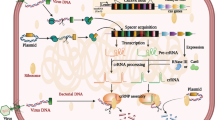Abstract
Intracellular bacterial pathogens use secreted effector proteins to alter host cellular processes, with the goal of subverting host defenses and allowing the infection to progress. One such pathogen, Legionella pneumophila, secretes ~300 proteins into its host to alter a number of pathways including intracellular trafficking, phosphoinositide metabolism, and cell signaling. The Legionella effector SidC was previously found to bind to PI(4)P and was responsible for the enrichment of ER proteins and ubiquitinated species on the Legionella-containing vacuoles. Through our recent work, we have discovered that SidC contains a unique N-terminal E3 ubiquitin ligase domain and a C-terminal novel PI(4)P-binding domain. Our results demonstrate that SidC serves to link two distinct cellular pathways, ubiquitin and phosphoinositide. However, how the ubiquitin ligase activity regulates host membrane trafficking events remains to be investigated.
Similar content being viewed by others
References
Alomairi J et al (2015) Alterations of host cell ubiquitination machinery by pathogenic bacteria. Front Cell Infect Microbiol 5:17
Alli OAT et al (2000) Temporal pore formation-mediated egress from macrophages and alveolar epithelial cells by Legionella pneumophila. Infect Immun 68(11):6431–6440
Balla T (2013) Phosphoinositides: tiny lipids with giant impact on cell regulation. Physiol Rev 93(3):1019–1137
Brombacher E et al (2009) Rab1 guanine nucleotide exchange factor SidM is a major phosphatidylinositol 4-phosphate-binding effector protein of Legionella pneumophila. J Biol Chem 284(8):4846–4856
Cunha BA, Burillo A, Bouza E (2015) Legionnaires’ disease. Lancet. doi:10.1016/S0140-6736(15)60078-2
De Felipe KS et al (2008) Legionella eukaryotic-like type IV substrates interfere with organelle trafficking. PLoS Pathog 4(8):e1000117
Di Paolo G, De Camilli P (2006) Phosphoinositides in cell regulation and membrane dynamics. Nature 443(7112):651–657
Dolinsky S et al (2014) The Legionella longbeachae Icm/Dot substrate SidC selectively binds phosphatidylinositol 4-phosphate with nanomolar affinity and promotes pathogen vacuole-endoplasmic reticulum interactions. Infect Immun 82(10):4021–4033
Gao L-Y, Kwaik YA (2000) The modulation of host cell apoptosis by intracellular bacterial pathogens. Trends Microbiol 8(7):306–313
Gazdag EM et al (2014) The structure of the N-terminal domain of the Legionella protein SidC. J Struct Biol 186(1):188–194
Gorvel JP, Moreno E (2002) Brucella intracellular life: from invasion to intracellular replication. Vet Microbiol 90(1):281–297
Havey JC, Roy CR (2015) Toxicity and SidJ-mediated suppression of toxicity require distinct regions in the SidE family of legionella pneumophila effectors. Infect Immun 83(9):3506–3514
Hicks SW, Galán JE (2010) Hijacking the host ubiquitin pathway: structural strategies of bacterial E3 ubiquitin ligases. Curr Opin Microbiol 13(1):41–46
Hilbi H (2006) Modulation of phosphoinositide metabolism by pathogenic bacteria. Cell Microbiol 8(11):1697–1706
Hilbi H, Weber S, Finsel I (2011) Anchors for effectors: subversion of phosphoinositide lipids by Legionella. Front Microbiol 2:91
Horenkamp FA et al (2014) Legionella pneumophila subversion of host vesicular transport by SidC effector proteins. Traffic 15(5):488–499
Hsu F et al (2012) Structural basis for substrate recognition by a unique Legionella phosphoinositide phosphatase. Proc Natl Acad Sci 109(34):13567–13572
Hsu F et al (2014) The Legionella effector SidC defines a unique family of ubiquitin ligases important for bacterial phagosomal remodeling. Proc Natl Acad Sci 111(29):10538–10543
Hubber A, Roy CR (2010) Modulation of host cell function by Legionella pneumophila type IV effectors. Annu Rev Cell Dev Biol 26:261–283
Huibregtse J, Rohde JR (2014) Hell’s BELs: bacterial E3 ligases that exploit the eukaryotic ubiquitin machinery. PLoS Pathog 10(8):e1004255
Ingmundson A et al (2007) Legionella pneumophila proteins that regulate Rab1 membrane cycling. Nature 450(7168):365–369
Isberg RR, O’Connor TJ, Heidtman M (2009) The Legionella pneumophila replication vacuole: making a cosy niche inside host cells. Nat Rev Microbiol 7(1):13–24
Jeong KC, Sexton JA, Vogel JP (2015) Spatiotemporal regulation of a Legionella pneumophila T4SS substrate by the Metaeffector SidJ. PLoS Pathog 11(3):e1004695
Knodler LA, Steele-Mortimer O (2003) Taking possession: biogenesis of the Salmonella-containing vacuole. Traffic 4(9):587–599
Komander D, Rape M (2012) The ubiquitin code. Annu Rev Biochem 81:203–229
Kubori T et al. (2010) Legionella metaeffector exploits host proteasome to temporally regulate cognate effector. PLoS Pathog 6(12):e1001216
Luo X et al (2015) Structure of the Legionella virulence factor, SidC reveals a unique PI (4) P-specific binding domain essential for its targeting to the bacterial phagosome. PLoS Pathog 11(6):e1004965
Metzger MB, Hristova VA, Weissman AM (2012) HECT and RING finger families of E3 ubiquitin ligases at a glance. J Cell Sci 125(3):531–537
Murata T et al (2006) The Legionella pneumophila effector protein DrrA is a Rab1 guanine nucleotide-exchange factor. Nat Cell Biol 8(9):971–977
Ogawa M et al (2005) Escape of intracellular Shigella from autophagy. Science 307(5710):727–731
Pickart CM, Eddins MJ (2004) Ubiquitin: structures, functions, mechanisms. Biochim Biophys Acta Mol Cell Res 1695(1):55–72
Pizarro-Cerdá J, Cossart P (2004) Subversion of phosphoinositide metabolism by intracellular bacterial pathogens. Nat Cell Biol 6(11):1026–1033
Ragaz C et al (2008) The Legionella pneumophila phosphatidylinositol-4 phosphate-binding type IV substrate SidC recruits endoplasmic reticulum vesicles to a replication-permissive vacuole. Cell Microbiol 10(12):2416–2433
Rotin D, Kumar S (2009) Physiological functions of the HECT family of ubiquitin ligases. Nat Rev Mol Cell Biol 10(6):398–409
Russell DG, Mwandumba HC, Rhoades EE (2002) Mycobacterium and the coat of many lipids. J Cell Biol 158(3):421–426
Toulabi L et al (2013) Identification and structural characterization of a Legionella phosphoinositide phosphatase. J Biol Chem 288(34):24518–24527
Varshavsky A (2012) The ubiquitin system, an immense realm. Annu Rev Biochem 81:167–176
Weber SS et al (2006) Legionella pneumophila exploits PI (4) P to anchor secreted effector proteins to the replicative vacuole. PLoS Pathog 2(5):e46
Weber SS, Ragaz C, Hilbi H (2009) Pathogen trafficking pathways and host phosphoinositide metabolism. Mol Microbiol 71(6):1341–1352
Xu L, Luo Z-Q (2013) Cell biology of infection by Legionella pneumophila. Microbes Infect 15(2):157–167
Acknowledgments
This work was supported by National Institutes of Health (NIH) Grants R01-GM094347 (Y.M.).
Author information
Authors and Affiliations
Corresponding author
Additional information
Communicated by M. Kupiec.
Rights and permissions
About this article
Cite this article
Wasilko, D.J., Mao, Y. Exploiting the ubiquitin and phosphoinositide pathways by the Legionella pneumophila effector, SidC. Curr Genet 62, 105–108 (2016). https://doi.org/10.1007/s00294-015-0521-y
Received:
Revised:
Accepted:
Published:
Issue Date:
DOI: https://doi.org/10.1007/s00294-015-0521-y




